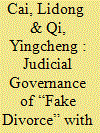| Srl | Item |
| 1 |
ID:
165607


|
|
|
|
|
| Summary/Abstract |
“Fake divorce” is a phenomenon unique to China that re�ects the di�-
culty of harmonizing the social governance model under traditional
familism ( 家戶主義 jiahuzhuyi) with the trend toward individualization during Chinese society’s transition from a planned to a market
economy. �at di�culty and the absence of regulatory rules leave room
for the Chinese courts to innovatively interpret prevailing laws/regulations and create judicial rules by exercising their own discretion. By
analyzing the role the courts have played in adjudicating fake-divorcerelated disputes as well as the relationship between the judicial system
and overall political system, this article reveals their role in modernizing Chinese society during the transition period. It argues that
although judicial power remains embedded in the sociopolitical system,
the courts are to a certain extent so�ening the contradiction between
rigid policies and practical realities through the innovative exercise of
judicial rationality. In sum, the general approach adopted by the
Chinese courts in dealing with fake divorce disputes represents a
rational choice based on the exercise of limited judicial resources and
measures rather than a mechanical application of laws or rigid implementation of government policies and goals.
|
|
|
|
|
|
|
|
|
|
|
|
|
|
|
|
| 2 |
ID:
186614


|
|
|
|
|
| Summary/Abstract |
Earlier anecdotal evidence suggests that judicially-developed doctrines, concepts, principles, norms and practices are disseminated not only downwards, but also upwards and horizontally, among Chinese courts. Methodologically, however, the rejection of the common law notion of precedents by China's civil law tradition has rendered any attempt to quantitatively track the dissemination of legal information an unrewarding exercise. The spread—and citations by mistake—of a non-existent judicial interpretation across all four levels of the Chinese judiciary has offered a rare window into the diffusion of law in China. Our research presents a first quantitative data-based evidence that hierarchical relationships between courts – top down, bottom up and horizontal – are at work in channeling information in the Chinese judiciary, particularly at the basic and intermediate levels. Another original contribution of our research is that it empirically demonstrates the role of cultural and geographical bonds in facilitating the dissemination of information among Chinese courts. Overall, our research provides fresh evidence for the presence of a robust, professional community of Chinese courts and judges, wherein novel laws, norms, information and practices flow and come to influence decision making.
|
|
|
|
|
|
|
|
|
|
|
|
|
|
|
|